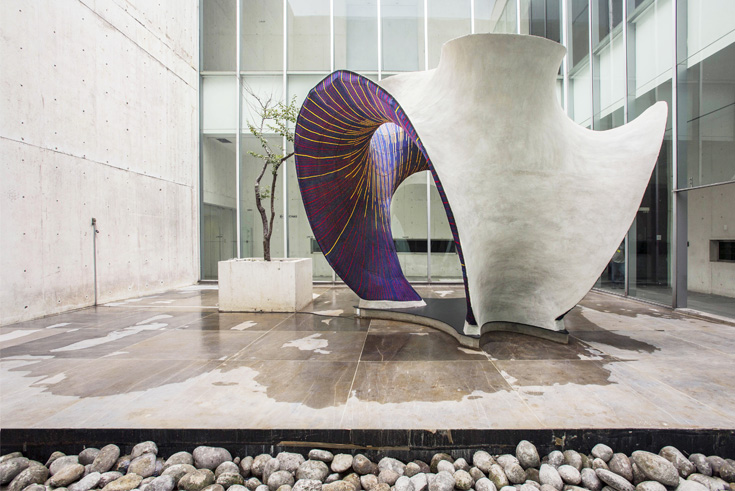Concrete shell made of steel cables and knitted formwork

KnitCandela: Der Prototyp der geschwungene Betonschale im Museo Universitario Arte Contemporáneo in Mexiko-Stadt (Foto: Juan Pablo Allegre)
KnitCandela is a curved concrete shell consisting of an ultra-light steel cable net and knitted formwork. The knitted fabric panels were transported to the construction site in just two cases. The prototype in the Museo Universitario Arte Contemporáneo in Mexico City is a tribute to the master of concrete shell construction, Félix Candela (1910–1997). In order to reuse formwork elements, Candela used hyperbolic paraboloid surfaces (hypars for short). With the same goal of reducing material consumption in formwork construction, the steel cable net and knitted formwork system extends the range of anti-clastic – i.e. mutually curved – geometries by an efficient and economically-feasible variant.
55 kg of formwork for 5 t of concrete
KnitCandela's double-curved concrete shell covers a surface area of almost 50m2 and weighs more than 5 tons, although the textile formwork, which was stretched in a temporary formwork frame, weighed only 55 kg. The steel cable and knitted formwork system is a further development of the principle of the HiLo roof prototype (High performance, Low energy), a curved, ultralight concrete roof. The main advantage of the current project is that the lightweight on-site formwork consists of a user-defined 3D knitted technical textile. Sprayed with a special cement coating, sufficient stiffness is created for application on concrete. Compared to woven fabrics, the knitting technique minimizes the need for patterns to create complex surfaces and allows the integration of additional features such as channels and openings in a seamless process.
Digital 3D cut pattern
The textile formwork consists of four long strips 15 to 26 m in length, which were produced in just 36 hours by an industrial knitting machine. Each of the four elements is a double-layered textile created in just one step. Its two layers perform different tasks: The visible, aesthetic inner layer displays a colourful pattern, while the outer, technical layer contains openings for inserting, guiding and positioning the steel cables and other formwork elements. Pockets created between the two textile layers were inflated with standard modelling balloons, the shape of which can be controlled by using different outer-layer knitting densities. After fixing the knitted formwork surface using a fast curing, cementitious coating, the fibre concrete layer was applied by hand by local craftsmen. The pockets filled manually with balloons became cavities in the concrete shell and formed a stiffening ribbed structure.

